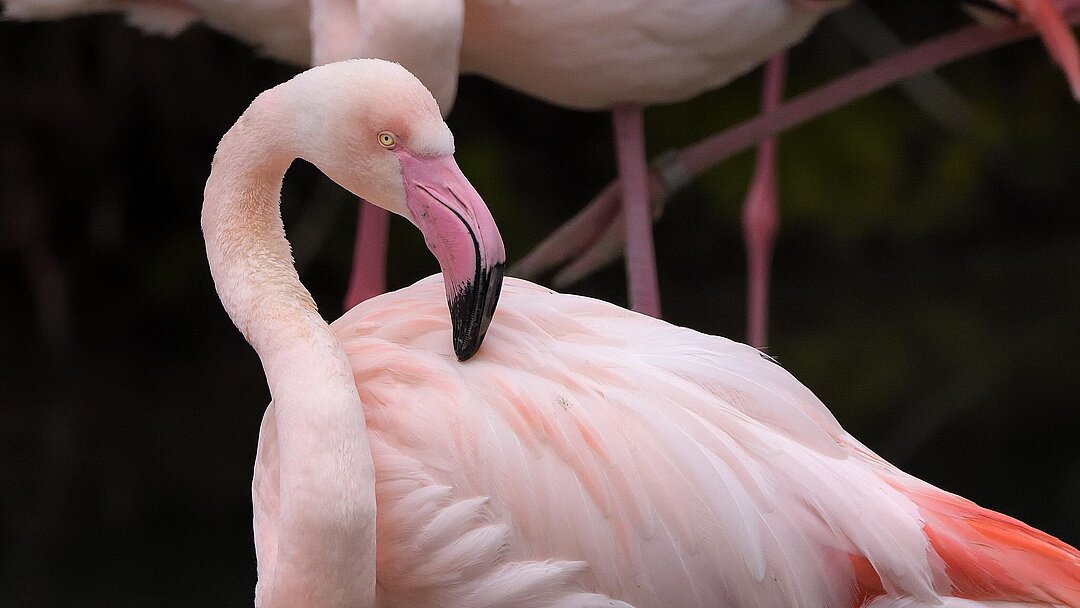
As of last week, the number of flamingos at Hellabrunn Zoo has almost halved. This may not sound like good news, but in fact it is. Because thanks to pioneering scientific research, the zoo was for the first time able to identify the exact species of each resident flamingo using genetic analysis: American flamingo, greater flamingo or their hybrid.
The American flamingo is the brightest of the flamingo species and can easily be distinguished from the greater flamingo, which has a less vibrant pinkish-white plumage. But what about their hybrids? How easy is it for the average person to tell the difference?
Until recently, Hellabrunn Zoo was home to both greater and American flamingos and their offspring, the so-called hybrids. In order to prevent the growth of the hybrid population, in 2019 Hellabrunn Zoo decided it would no longer keep flamingo offspring. “While the red American flamingos can easily be distinguished from the pink greater flamingos, the difficulty has always been to identify all the hybrids,” explains Lena Bockreiß, curator of flamingos at Hellabrunn Zoo. “That’s why we asked the research community for help. By using genetic analysis, they were able to identify beyond doubt the exact species of each individual flamingo.”
Prof Dr Willems from the Justus Liebig University in Giessen, working in collaboration with the zoo, succeeded in identifying the species of all 94 flamingos living at Hellabrunn for the first time. The result: 55 greater flamingos, two American flamingos and 37 hybrids. “So we were able to decide which animals we would give to other zoos and which ones we would keep in order to maintain a greater flamingo-only group at the zoo in the future in accordance with the studbook and to restore our breeding programme,” adds Bockreiß. The study represents the world's first scientific genetic differentiation of greater flamingos, red flamingos and their hybrids and highlights the important contribution of zoos to scientific research. The study will be published in detail next year.
The American and hybrid flamingo residents were transferred to Sóstó Zoo in Hungary, Łączna Zoo in Poland and Cologne Zoo last week. The birds remaining at Hellabrunn were re-ringed for better identification. This also helps the staff to better recognise breeding pairs. Zoo director Rasem Baban is already looking forward to next summer: "I'm pleased that we can now expand our flamingo group again through breeding and I'm keeping my fingers crossed that we'll be able to observe many breeding pairs hatching their eggs and raising their young in the spring."
Flamingos build tall mud nests, which are usually concave at the top to prevent the large single egg from falling out. After an incubation period of about 30 days, the egg hatches and the chick is cared for by both parents. Both the mother and the father produce a type of milk called crop milk in the upper digestive tract, which is similar to the breast milk of mammals.
Flamingos are one of the oldest bird groups. They have existed on Earth in their current form for 30 million years. Greater flamingos are native to Asia, Africa and southern Europe. Their ability to adapt enables them to inhabit not only temperate climate zones, but also colder regions - this explains why the flamingos at Hellabrunn Zoo can thrive outside in temperatures close to zero degrees in their aviary by the Auer Mühlbach river, which features a new cover netting installed in spring 2022. The birds are only brought into the aviary‘s heated house if the temperature falls below freezing.
Like their fellow species in the wild, the flamingos at Hellabrunn also get their bright colour from carotenoids found in their food, which are deposited as a dye in the feathers. If they are not fed the same level of algae and crustaceans they normally obtain in the wild, their bright colour will quickly fade – even if otherwise well nourished.